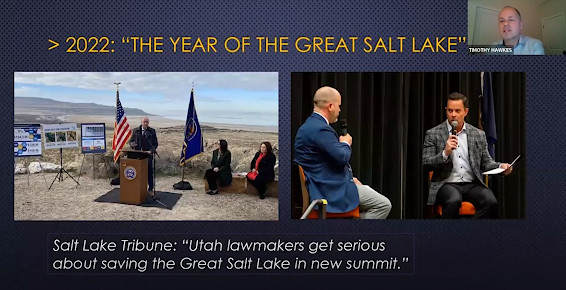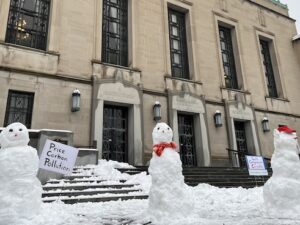CCL Utah event discusses Great Salt Lake, state climate initiatives
By Katie Zakrzewski
Recent CCL awareness campaigns highlighting the need for the protection of the Great Salt Lake have spurred an influx of new volunteers to join CCL Utah. Utah State Coordinator Tom Moyer sprang into action to connect these new volunteers with their state legislators by holding a virtual event focused on conserving and protecting the Great Salt Lake.
“The Great Salt Lake event helped us address some of the concerns related to the lake,” Tom said. “The whole American West is drying, and a portion of that drying is from climate change.”
The event focused broadly on the importance of protecting the environment and the Great Salt Lake, which is a treasured location in Utah. Utah Republican Rep. Tim Hawkes, who is an expert in environmental science and the Great Salt Lake, was a featured speaker. Seven other local legislators were in attendance as well.
“This event was an effort to engage the new CCLers that we’ve been getting,” Tom said. “We’ve had a lot of people joining with interest in the Great Salt Lake, so the purpose of this event was to help educate them about the causes of the problem while also building ties with our legislators.”
Republican leadership on environmentalism in Utah
Rep. Tim Hawkes has been an environmental champion for his entire career. He’s worked for Trout Unlimited, as well as the brine shrimp industry. He’s made the Great Salt Lake a priority in his legislation and has brought many Republican lawmakers along with him. Rep. Hawkes explained in his presentation that Republicans, contrary to some mainstream stereotypes, do not hate the environment.
“We’re often told that Republicans do not care about the environment because they care about money. That’s just not true. So I push back hard against this notion that we hate the environment,” Rep. Hawkes said. “The truth of the matter is that this is an issue that is bipartisan and needs to remain bipartisan.”
The Great Salt Lake plays a pivotal role in the well-being of Utah. The lake helps keep air in the surrounding area clean from dust and minimizes the effects of potential dust storms, lowering the rate of respiratory illness. Additionally, the lake is a source of many of the minerals used in manufacturing throughout Utah, such as magnesium and lithium, which are found in soda cans, cell phones, and batteries. It’s also an important ecosystem for animals and wildlife, such as migratory birds.
Solutions for preserving the Great Salt Lake
The primary issue the Great Salt Lake faces is water diversion — something that the media tends to get wrong. A recent report from Brigham Young University found that climate contribution is directly responsible for 9% of lake loss, 20% is naturally occurring drought, and the rest is water diversion.
“While it’s true that drought is amplified by climate change, there are other solutions to solving this problem that are more immediate,” Tom said. “There are more tangible solutions and quicker responses that we can be working on while also working on climate change in the background.”
Rep. Hawkes highlighted some of the policies that have been passed within the last few years to decrease water diversion, including water banking. Utah’s state legislature passed legislation, sponsored by Rep. Joel Ferry (who is now the Director of the Utah Department of Natural Resources), that allowed farmers to temporarily assign their water rights to the lake instead of wasting water allotments to prevent a decrease in next year’s allotment.
Tom says that working on environmental issues, such as water diversion from the Great Salt Lake, is representative of the efforts by CCLers in Utah to mitigate the effects of climate change.
“It’s very analogous to climate change — the solutions are super similar. Solving it costs money, but not addressing it would be disastrous, and the state is being proactive in coming up with smart solutions,” Tom said. “So to me, it’s really helpful…CCLers in Utah see Utah as a high-value state in the climate landscape. Utah is a bright spot for rationality and concern among red states.”
Building relationships across the aisle
Republican attendance at this event is proof of Utah’s position within Republican involvement on climate change, as well as the importance of building bridges with new members of the legislature.
“Other than Rep. Hawkes, we had seven other legislators attend this event. Of those seven, four were Republicans, three were Democrats, and all four Republicans are freshman legislators, as well as one of the Democrats,” Tom explained. “Those freshmen are four new Republicans that now have a positive first impression of CCL. We have brought in their friend as our expert, and not without good reason. He is a topic expert, and they’ve seen us on good terms with him. So the next time we call them and ask them to vote on something, they’ll remember us. New CCL members have a good impression of CCL now too. They’ve got a chance to see how well CCL works with the legislature. ”
The event, Tom said, helped assuage some of the concerns and skepticism that new CCLers in Utah had.
“Some of the people who had joined CCL Utah over the last year were more climate-focused and Republican skeptical. Rep. Hawkes is really persuasive, and folks were blown away by how wonderful he is and some of the things that he had to say at this event,” Tom said. “People are always surprised at how warm it is between him and CCL; this gives us a credibility boost.”
The future of advocacy and the Great Salt Lake
Given the close connection between the general environmentalism in caring for the Great Salt Lake and the impact of climate change, Tom and other CCLers acknowledge that this is a promising indicator for the future of climate legislation in Utah.
“To see the state lead on environmental issues and seriously tackle an upcoming problem before it becomes any worse, to see the state becoming proactive, is really helpful for all of us in hoping to see the state move on climate change. We’re always looking for ways to express gratitude, and this gives us a really good one for state legislators and to cheer them on to federal legislators,” Tom explained.
Tom provided a glimpse into what future legislative endeavors might look like in CCL Utah for protecting and preserving the Great Salt Lake.
“For the Great Salt Lake, we’ll track water bills at the state level, as well as energy bills, which have a pretty strong climate component,” Tom said. “Tracking water bills gives us the opportunity to ask legislators to vote for things that they are likely to support. It’s also great for a lot of our members to see which bills they’re interested in.”
At the end of the day, Tom said, it’s all about creating connections.
“It’s all about building relationships. Even if we don’t know the immediate goal, these folks will become energy and climate champs further down the road,” Tom said. “Whether it’s for the Great Salt Lake or the climate, these relationships have the ability to make the difference.”






